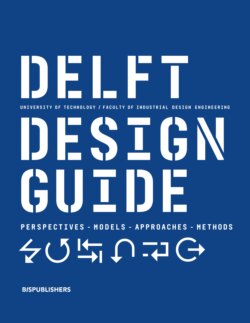Читать книгу Delft Design Guide -Revised edition - Annemiek van Boeijen - Страница 10
На сайте Литреса книга снята с продажи.
ОглавлениеPreface
The Delft Design Guide originated from the need for a more comprehensive overview, deeper insight, and stronger assistance in choosing and understanding the right perspective while establishing the design goal, understanding theoretical models, and selecting appropriate approaches and methods that help with the actual development of products, services, and other manifestations of a creative process. We are truly pleased to know that the book is now used in many different places around the world, both in the educational institutions and in practice. The book has also helped in shaping a common image and language that contributes to the Delft design culture that has found its way around the world through this book. Additionally, the graphic design and layout of the book helped to make it an inspiring and accessible reference work, and for this we thank Yvo Zijlstra of Antenna-Men. As a result, the Delft Design Guide is currently used in various design disciplines and at different schools around the world. Thanks to one of our Chinese alumni, the Delft Design Guide has even been published in Chinese since 2014. Since 2015, there is also a Japanese version.
This is a completely revised Delft Design Guide. Like the first edition, published in 2013, this book once again offers a collection of perspectives, models, approaches, and methods that are used in the design education at TU Delft. The book offers a toolbox, an important asset for designers and it offers insight into the distinct Delft Design Thinking. We are proud that the Delft Design Guide is a project of co-creation and the result of a bottom-up approach, in which we created the content together with our many colleagues.
Our field is rapidly changing; after six years, we deemed that the time was ripe for a compre- hensive review and renewal. The integration model of People, Technology, and Organisation is still central. The discipline is shifting from a focus on mostly physical products and individual users to a zoomed-out level in which products and individuals are part of a larger system. Non-physical designs, such as in services, and indirect users also play a role in that larger system. There is also more attention to the effect of design on people, the environment, and society: the raison d’être of design. Design therefore becomes increasingly complex and requires new or adapted working methods.
The new Delft Design Guide distinguishes itself from the previous edition on several points. First, more than one-third of this book consists of new content and pages. Second, this book is organised into a clearer structure with distinctive categories (perspectives, models, approaches, and methods). Third, some topics have been removed, whereas others have been merged. Finally, all subjects are improved and enriched with the ‘mindset’ component that explains the underlying values and principles.
We wish everyone good luck and an enjoyable learning experience with the new Delft Design Guide!
Editors
Annemiek van Boeijen
Jaap Daalhuizen
Jelle Zijlstra
9
